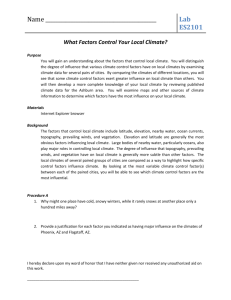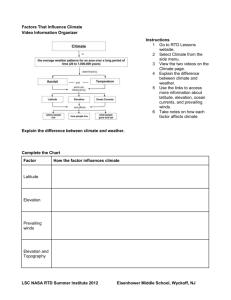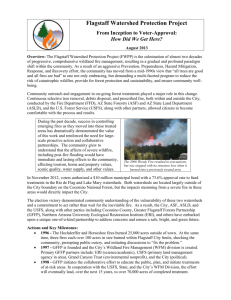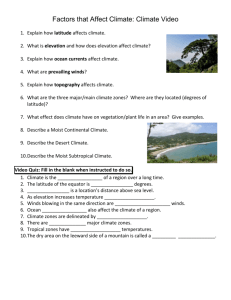Climate & Climate Control Factors Worksheet
advertisement
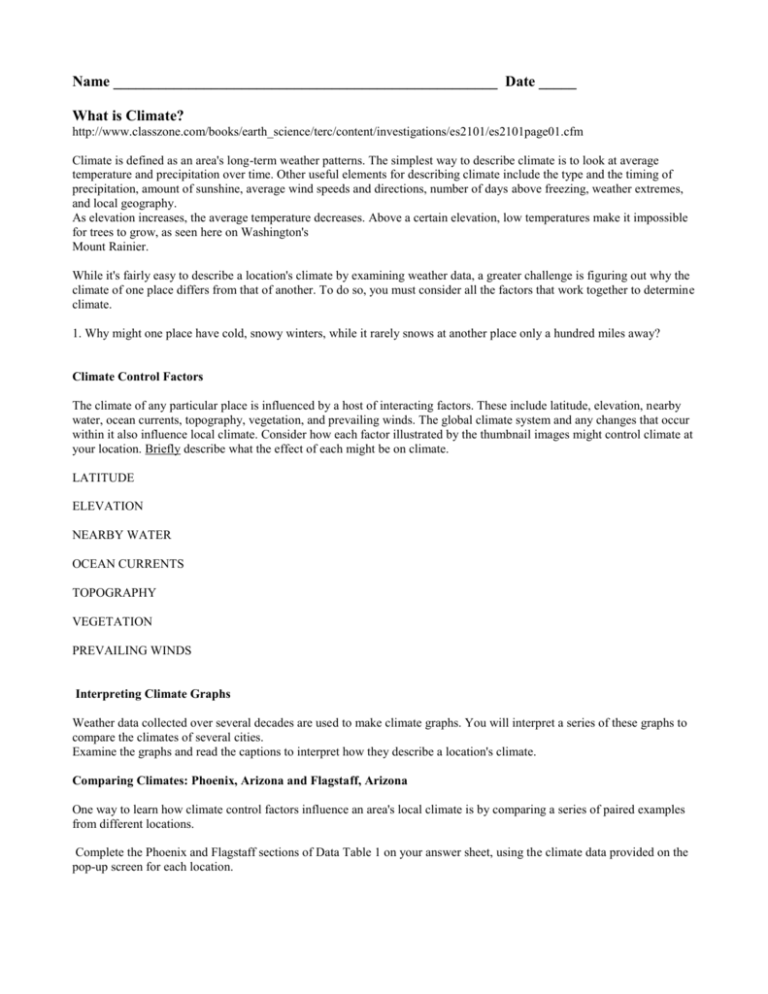
Name ___________________________________________________ Date _____ What is Climate? http://www.classzone.com/books/earth_science/terc/content/investigations/es2101/es2101page01.cfm Climate is defined as an area's long-term weather patterns. The simplest way to describe climate is to look at average temperature and precipitation over time. Other useful elements for describing climate include the type and the timing of precipitation, amount of sunshine, average wind speeds and directions, number of days above freezing, weather extremes, and local geography. As elevation increases, the average temperature decreases. Above a certain elevation, low temperatures make it impossible for trees to grow, as seen here on Washington's Mount Rainier. While it's fairly easy to describe a location's climate by examining weather data, a greater challenge is figuring out why the climate of one place differs from that of another. To do so, you must consider all the factors that work together to determine climate. 1. Why might one place have cold, snowy winters, while it rarely snows at another place only a hundred miles away? Climate Control Factors The climate of any particular place is influenced by a host of interacting factors. These include latitude, elevation, nearby water, ocean currents, topography, vegetation, and prevailing winds. The global climate system and any changes that occur within it also influence local climate. Consider how each factor illustrated by the thumbnail images might control climate at your location. Briefly describe what the effect of each might be on climate. LATITUDE ELEVATION NEARBY WATER OCEAN CURRENTS TOPOGRAPHY VEGETATION PREVAILING WINDS Interpreting Climate Graphs Weather data collected over several decades are used to make climate graphs. You will interpret a series of these graphs to compare the climates of several cities. Examine the graphs and read the captions to interpret how they describe a location's climate. Comparing Climates: Phoenix, Arizona and Flagstaff, Arizona One way to learn how climate control factors influence an area's local climate is by comparing a series of paired examples from different locations. Complete the Phoenix and Flagstaff sections of Data Table 1 on your answer sheet, using the climate data provided on the pop-up screen for each location. DATA TABLE 1 Variable latitude Phoenix Flagstaff Boston North Bend Dallas Fargo Syracuse longitude elevation Max Temp Min Temp Mean Annual Precip Mean Annual Snow Temp Max Jan/July Temp Min Jan/July Precip (All) Jan/July Precip (Snow) Jan/July How to determine which climate control factors cause major differences in climate between Phoenix and Flagstaff. Compare each of the climate variables in Data Table 1 for which you recorded data. Next, identify the climate variables that are the most different between the two locations. For this example, significant differences exist in the amount of snow precipitation that falls in Flagstaff compared to Phoenix. There are also major differences in the minimum and maximum temperatures for January as well as July. Now, think about which climate control factors (latitude, elevation, water, ocean currents, topography, prevailing winds, or vegetation) are likely to cause these major differences between the local climates of Phoenix and Flagstaff. Notice that there is a large difference in elevation between Phoenix and Flagstaff, but not much difference in latitude. Elevation must therefore play a major role in determining the local climate for each place, because these two cities are not very far away from each other. Some climate control factors have greater influence than others, depending upon the location of the place being considered. For example, water has little influence on the climate of Phoenix and Flagstaff because no major bodies of water are located near either of these places. In Data Table 2, indicate which climate control factors (latitude, elevation, water, ocean currents, topography, prevailing winds, or vegetation) appear to have major influence on the local climates of Phoenix and Flagstaff. Next, indicate which climate control factors appear to have minor influence. DATA TABLE 2 Climate Factors MAJOR Influences Phoenix Flagstaff Boston North Bend Dallas Fargo Syracuse Minor Influences 2. Provide a justification for each factor you indicated as having major influence on the climates of Phoenix, Arizona and Flagstaff, Arizona. 3. Summarize the major differences in climate between Boston, Massachusetts and North Bend, Oregon. Determine which climate control factors cause major differences in the climate between Boston and North Bend using the same process as in the previous comparison. Record your evaluation in Data Table 2. 4. Provide a justification for each factor you indicated as having major influence on the climates of Boston, Massachusetts and North Bend, Oregon. 5. Summarize the major differences in climate between Fargo, North Dakota and Dallas, Texas. Determine which climate control factors cause major differences in the climate between Fargo and Dallas. Record your evaluation in Data Table 2. 6. Provide a justification for each factor you indicated as having major influence on the climates of Fargo, North Dakota and Dallas, Texas. Describe Your Local Climate Now, you'll collect data about your own local climate, or the climate of a major city near you. Climate graphs such as the ones you've been viewing are available for major cities in all 50 states. 7. On another sheet of paper, write a description of your local climate. Discuss characteristics such as timing and types of precipitation you receive, minimum and maximum temperatures and their timing, and any other aspects you think most accurately describe your local climate. Describe the Factors That Control Your Local Climate Use what you've learned about climate controls to analyze the data you gathered for your location. Use the links below for additional information to help you determine which climate control factors most influence your local climate. Determine which climate control factors have a major effect on your location. Record your evaluation in the Syracuse column on Data Table 2. 8. Describe how each of the climate control factors in Data Table 2 influences your local climate.
